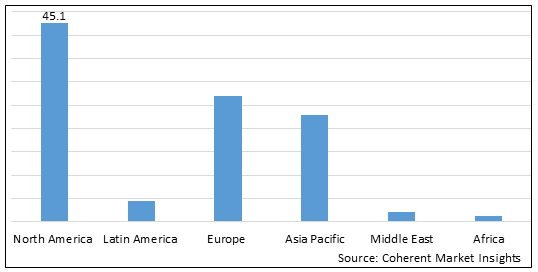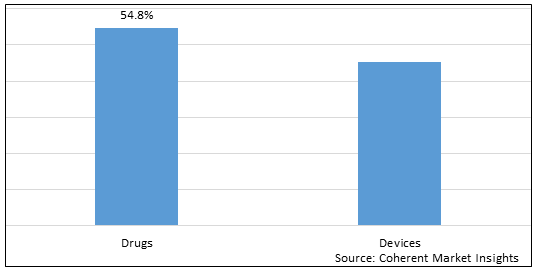The global posterior segment eye disorders market was valued at US$ 28,360.6 Mn in 2021 and is forecast to reach a value of US$ 39,213.5 Mn by 2028 at a CAGR of 5% between 2022 and 2028. The global posterior segment eye disorders market is experiencing strong growth due to the increase in burden of posterior segment eye disorders and rise in geriatric (aging) population across the globe. Moreover, increase in demand for safe and effective treatments and increase in focus on the development of new therapeutics is expected to boost growth of the market. However, factors such as stringent regulatory framework/policies and lack of primary infrastructure for eye diseases are expected to hamper growth of the market.
Global Posterior Segment Eye Disorders Market: Regional Insights
Based on geography, the global posterior segment eye disorders market is segmented into North America, Latin America, Europe, Asia Pacific, Middle East, and Africa.
Among regions, North America is expected to gain highest share in the market during the forecast period due to the rising burden of posterior segment eye disorders (glaucoma, age-related macular degeneration, and diabetic retinopathy) and growing geriatric population in the region. According to the National Eye Institute, there are many different types of glaucoma, but the most common type in the United States is called open-angle glaucoma. Other types such as congenital glaucoma and angle-closure glaucoma are less common. Glaucoma affects around three million people age 40 or older in the United States, around 1.9% of this population.
Europe is also expected to witness significant growth in the global posterior segment eye disorders market due to the increase in incidence/prevalence of posterior segment eye disorders and growing geriatric population in the region. For instance, according to the National Center for Biotechnology Information (NCBI), more than 67 million people in the European Union are currently affected by any AMD (age-related macular degeneration) and, due to growing geriatric population, and this number is expected to increase by 15% until 2050. This in turn is expected to increase the demand for posterior segment eye disorders treatment in the region.
Figure 1. Global Posterior Segment Eye Disorders Market Share (%), by Region, 2022

To learn more about this report, Download Free Sample
Global Posterior Segment Eye Disorders Market Drivers:
Increase in burden of posterior segment eye disorders to propel market growth
One of the key factors expected to augment growth of the global posterior segment eye disorders market over the forecast period is the increase in burden of posterior segment eye disorders across the world. Posterior segment eye disease (PSED) is defined as diseases of retina, choroid and optic nerve and includes glaucoma, age-related macular degeneration, and diabetic retinopathy. As per the American Academy of Ophthalmology, glaucoma is the most common cause of preventable, irreversible blindness worldwide, while primary open-angle glaucoma (POAG) is responsible for 12.3% of blindness worldwide. This in turn is driving the market growth.
Growing geriatric population worldwide to underpin market growth
Another factor which is driving the growth of the global posterior segment eye disorders market is the increase in geriatric (aging) population across the globe. The most common causes of vision loss among the elderly are age-related macular degeneration, glaucoma, diabetic retinopathy, and cataract. Vision loss among the elderly is a major health care problem. According to the American Academy of Family Physicians, around one person in three has some form of vision-reducing eye disease by the age of 65. Thus, with the growing geriatric population, the incidence of posterior segment eye disorders is also increasing rapidly.
Global Posterior Segment Eye Disorders Market Opportunities:
Increase in demand for safe and effective treatment worldwide is expected to provide significant growth opportunities for players in the global posterior segment eye disorders market. For instance, with the rise in burden of posterior segment eye disorders and increase in awareness among people, demand for for safe and effective treatment has also increased worldwide. In June 2022, Amring Pharmaceuticals Inc. (Amring) received the U.S. Food and Drug Administration (FDA) approval for generic Timolol Maleate Ophthalmic Solution, USP 0.5%, 60 pack of 0.3 mL unit dose vials (AT3 rated generic equivalent of Timoptic in Ocudose).
Increase in focus on the development of new therapeutics is expected to provide lucrative growth opportunities for players in the global posterior segment eye disorder market. For instance, players in the market are focusing on launching and developing novel therapeutics in the market to meet increase in demand worldwide. In August 2021, Zilia announced the closing of US$ 4 million seed funding round led by Anges Québec. This would help the company's entry into ocular diagnostics by increasing the number of diagnoses for posterior segment eye disorders. This in turn is expected to aid in the global posterior segment eye disorders market growth.
Posterior Segment Eye Disorders Market Report Coverage
| Report Coverage | Details | ||
|---|---|---|---|
| Base Year: | 2021 | Market Size in 2021: | US$ 28,360.6 Mn |
| Historical Data for: | 2017 to 2020 | Forecast Period: | 2022 to 2028 |
| Forecast Period 2022 to 2028 CAGR: | 5% | 2028 Value Projection: | US$ 39,213.5 Mn |
| Geographies covered: |
|
||
| Segments covered: |
|
||
| Companies covered: |
Novartis AG, Merck & Co. Inc., F. Hoffmann-La Roche AG, AbbVie Inc (Allergan), Alcon Inc., Bausch Health Companies Inc., Aerie Pharmaceuticals, Santen Pharmaceutical Co. Ltd., Second Sight Medical Products Inc., Rainbow Medical Ltd (Nano Retina), and Regeneron Pharmaceuticals Inc., among others. |
||
| Growth Drivers: |
|
||
| Restraints & Challenges: |
|
||
Uncover macros and micros vetted on 75+ parameters: Get instant access to report
Global Posterior Segment Eye Disorders Market Trends:
Frequent approvals and launches of novel products is a recent trend
Due to rise in burden of posterior segment eye disorders and growing geriatric population across the world, players in the market are focusing on launching and developing novel therapeutics. For instance, the U.S. Food and Drug Administration (FDA) and European Medicines Agency (EMA) have approved several drugs/therapeutics to treat posterior segment eye disorders. This in trend is expected to continue over the forecast period, driving the market growth.
Increase in burden of diabetes is another market trend
With the rise in burden of diabetes across the globe, the burden of eye disorders is also increasing with a rapid pace worldwide. Eye disorders, such as diabetic retinopathy, glaucoma, cataracts, and macular edema (which develops along with diabetic retinopathy), affect people with diabetes. This in turn has increased or is increasing the demand for safe & effective treatment, driving the growth of the global posterior segment eye disorders market.
Global Posterior Segment Eye Disorders Market Restraints:
Stringent rules and regulations to hinder growth of the market
One of the key factors expected to hamper the growth of the global posterior segment eye disorders market is the stringent regulatory framework/policies. Regulatory authorities, such as the US FDA and EMA, regulate the posterior segment eye disorder market to ensure access to safe, appropriate, and affordable diagnostics and therapeutics products. Moreover, most eye disorder drugs available without prescription are assessed and authorized at the national level, which in turn leads to delay in product launches and sometimes, product recalls.
Lack of primary infrastructure to hamper growth of the market
Another factor which is hampering the growth of the global posterior segment eye disorders market is the lack of primary infrastructure for eye diseases in developing and underdeveloped countries. The population in both developing and underdeveloped countries is increasing rapidly and hence the burden of diseases is increasing, which affects the medical/healthcare system in these regions due to lack of proper health care infrastructure for eye related diseases. However, infrastructure is now being developed in developing and underdeveloped countries.
Figure 2. Global Posterior Segment Eye Disorders Market Share (%), by Product, 2022

To learn more about this report, Download Free Sample
Global Posterior Segment Eye Disorders Market Segmentation:
The global posterior segment eye disorders market report is segmented into Product, Application, and Geography.
Based on Product, the global posterior segment eye disorders market is segmented into Drugs and Devices. Out of which, Drugs Segment is expected to dominate market during the forecast period and this is attributed to the increase in demand for safe and effective drugs; primarily used in the treatment of the posterior segment eye disorders.
Based on Application, the market is segmented into Macular Degeneration, Glaucoma, Diabetic Retinopathy, and Other Applications. Out of which, Glaucoma Segment is expected to dominate the market over the forecast period and this is attributed to the increase in prevalence of glaucoma across the world.
Diabetic Retinopathy Segment is also expected to witness significant growth in the near future and this is due to the rise in prevalence of diabetes. Diabetic retinopathy is a diabetes complication that affects eyes. Diabetic retinopathy is caused by high blood sugar due to diabetes.
Global Posterior Segment Eye Disorders Market: Key Developments
In November 2021, Alcon acquired Ivantis, Inc. to expand its product portfolio by adding Hydrus Microstent for surgical glaucoma. Hydrus Microstent is one of the key products in Canada. With this acquisition, Alcon will increase its presence in the market.
In October 2021, Roche received approval from the U.S. FDA for Susvimo (ranibizumab injection) 100 mg/mL for intravitreal use via ocular implant for the treatment of people with neovascular or “wet” age-related macular degeneration.
In February 2021, Topcon Healthcare launched its new Glaucoma Module which simplifies the diagnosis of glaucoma. These product launches are likely to increase the demand of the drugs and devices for the treatment of posterior segment eye disorders in the country.
In February 2020, IRIDEX Corporation launched a second generation of the MicroPulse P3 Device for glaucoma which is intuitive and easy to use, and as per the company, over 120,000 patients have been treated in over 60 countries with the original version of the MicroPulse P3 Device which is further expected to increase with the launch of the newer and advanced device.
Global Posterior Segment Eye Disorders Market: Key Companies Insights
The global posterior segment eye disorders market is highly competitive. This is attributed to the increase in burden of posterior segment eye disorders worldwide, as a result, players in the market are focusing on launching novel products in the market.
Some of the key players in the global posterior segment eye disorders market are Novartis AG, Merck & Co. Inc., F. Hoffmann-La Roche AG, AbbVie Inc (Allergan), Alcon Inc., Bausch Health Companies Inc., Aerie Pharmaceuticals, Santen Pharmaceutical Co. Ltd., Second Sight Medical Products Inc., Rainbow Medical Ltd (Nano Retina), and Regeneron Pharmaceuticals Inc.
*Definition: Posterior segment eye disease (PSED) is commonly defined as diseases of the retina, choroid & optic nerve and primarily include glaucoma, age-related macular degeneration (AMD), and diabetic retinopathy (DR). The therapeutic devices are primarily used in the treatment of the posterior segment eye disorders.
Share
Share
About Author
Ghanshyam Shrivastava - With over 20 years of experience in the management consulting and research, Ghanshyam Shrivastava serves as a Principal Consultant, bringing extensive expertise in biologics and biosimilars. His primary expertise lies in areas such as market entry and expansion strategy, competitive intelligence, and strategic transformation across diversified portfolio of various drugs used for different therapeutic category and APIs. He excels at identifying key challenges faced by clients and providing robust solutions to enhance their strategic decision-making capabilities. His comprehensive understanding of the market ensures valuable contributions to research reports and business decisions.
Ghanshyam is a sought-after speaker at industry conferences and contributes to various publications on pharma industry.
Missing comfort of reading report in your local language? Find your preferred language :
Transform your Strategy with Exclusive Trending Reports :
Frequently Asked Questions
Select a License Type
Joining thousands of companies around the world committed to making the Excellent Business Solutions.
View All Our Clients